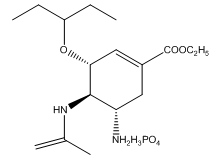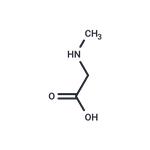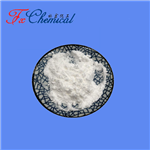Synthesis and Application of sarcosine
Jul 13,2022
General description
Sarcosine, also known as N-methylglycine, is an acid produced in the liver to provide energy to muscle cells. Sarcosine is most commonly found in vertebrates. It can be used as a kind of food health care products, but also as a raw material of creatine monohydrate, for some people with special needs to provide nutritional supplements. Sarcosine provides energy to muscle groups and helps the body recover from fatigue. Some fitness people often use supplements containing sarcosine. It can not only be used as health care products, but also have different roles in our food, industry and medicine industries.

Fig. 1 The structure of Sarcosine
Physicochemical property
The melting point of sarcosine is 204-212°C (Dec.)(lit.). The boiling point is roughly estimated at 165.17°C. The density is about 1.1948 g/mL. Sarine is usually a white crystalline powder, slightly sweet, deliquictic, soluble in water, slightly soluble in ethanol, insoluble in ether.
Synthetic routes

Fig. 2 The synthetic scheme 1 of Sarcosine.
Aliphatic alcohols (1.0 mmol), 1a (Cas: 2069173-99-3, 0.5–2 mol %), KOH (4 equiv.) and 1.5 mL anisole were charged sequentially in a 25 mL tube with a magnetic bar. The reaction tube attached with an open bubbler was stirred and heated at 140 °C for 24 h. After the reaction completion, water (5 mL) was added into the tube, and the reaction mixture was extracted with diethyl ether (3 × 5 mL). Then the aqueous phase was then acidified with HCl (6 M), and further extracted with ethyl acetate (3 × 10 mL). The combined ethyl acetate layer was then washed with brine (15 mL), dried over anhydrous Na2SO4. After filtration and evaporation, the desired pure acids was obtained [1].

Fig. 3 The synthetic scheme 2 of Sarcosine.
Weigh N equivalents of PSar N-carboxyanhydride into a Schlenk tube. Dry the mixture under vacuum for 1 hour. Dissolve the mixture in absolute DMF. Prepare a stock solution of either mannose initiator or neopentylamine in absolute DMF in a separate Schlenk tube. Join the both solutions via syringe to yield a final monomer concentration of 0.1 g ·mL-1. Stir the polymerization solution at room temperature for 3 days. Keep the polymerization solution at a constant pressure of 1.25 bar of dry nitrogen via the Schlenk line to prevent impurities from entering the reaction vessel while allowing CO2 to escape. Completion of the reaction is confirmed by infrared spectroscopy. Directly after completion of the reaction, precipitate the product in cold diethyl ether. Centrifuge the product (4500 rpm at 4 °C for 15 minutes). After discarding the liquid fraction, add new ether to the mixture. Resuspend the polymer using a sonic bath. Centrifuge the suspension again. Repeat the procedure. Remove the DMF by the resuspension steps. Dissolve the polymer water. Lyophilize the product [2].
Functions and Uses
1. Sarcosine can be used as dye stabilizer for industrial products, and amino acid surfactant for daily chemicals. It has become the main raw material for the production of health medicine fatigue recovery agent - water creatine, the synthesis of anti-enzyme agent, biological reagent.
2. Sarcosine boosts intelligence, especially in situations that require a "temporary boost in intelligence," such as a student taking an exam.
3. Sarcosine supplementation can increase muscle anaerobic strength and explosive power. Sarine exists in muscle in the form of phosphocreatine. The human body mainly relies on ATP to provide energy during high-intensity exercise, but ATP reserves in the human body are very small and need to be continuously synthesized, and phosphocreatine can promote the synthesis of ATP.
4. Prevent damage caused by brain injury.
5. Sarcosine improves performance, strength, recovery time and lean muscle mass.
The Relationship between Sarcosine and Prostate Cancer
The Role of Sarcosine Metabolism in Prostate Cancer Progression
In 2009, Sreekumar found that sarcosine, as an effective biomarker, can be used to identify prostate cancer. Metabolomic profiling of prostate cancer (PCa) progression identified markedly elevated levels of sarcosine (N-methyl glycine) in metastatic PCa and modest but significant elevation of the metabolite in PCa urine. Chinnaiyan et al. examine the role of key enzymes associated with sarcosine metabolism in PCa progression. Consistent with their earlier report, sarcosine levels were significantly elevated in PCa urine sediments compared to controls, with a modest area under the receiver operating characteristic curve of 0.71. In addition, the expression of sarcosine biosynthetic enzyme, glycine N-methyltransferase (GNMT), was elevated in PCa tissues, while sarcosine dehydrogenase (SARDH) and pipecolic acid oxidase (PIPOX), which metabolize sarcosine, were reduced in prostate tumors. Consistent with this, GNMT promoted the oncogenic potential of prostate cells by facilitating sarcosine production, while SARDH and PIPOX reduced the oncogenic potential of prostate cells by metabolizing sarcosine. Accordingly, addition of sarcosine, but not glycine or alanine, induced invasion and intravasation in an in vivo PCa model. In contrast, GNMT knockdown or SARDH overexpression in PCa xenografts inhibited tumor growth. Taken together, these studies substantiate the role of sarcosine in PCa progression [3].
Detection method
It is difficult to detect sarcosine in urine or plasma because of its low concentration. Yang et al. describe a simple strategy for the preparation of sarcosine biosensor based on platinumloaded mesoporous nickel phosphonate (Pt/MNP) and subsequently apply it to detect sarcosine. Mesoporous structure could increase the active sites on the MNP surface, which makes the Pt/MNP have excellent electrochemical performance for detecting hydrogen peroxide, one of the enzymatic products, and the sarcosine biosensor exhibited a superior electrochemical performance. The linear range of sarcosine biosensor is from 5 to 40 μM and the sensitivity is 123.51 μA mM-1 cm-2. The limit of detection is estimated to be 0.24 μM (S/N = 3). Additionally, the sarcosine biosensor based on Pt/MNP also shows an excellent performance in the anti-interference test and the real serum sample. This work manifests the potential application of Pt/MNP as a novel biosensor material for sarcosine detection, which could be extended to other oxidase-based detection systems [4].
References
[1] Yin S, Zheng Q, Chen J, et al. Acceptorless dehydrogenation of primary alcohols to carboxylic acids by self-supported NHC-Ru single-site catalysts[J]. Journal of Catalysis, 2022, 408: 165-172.
[2] Heller P, Mohr N, Birke A, et al. Directed Interactions of Block Copolypept (o) ides with Mannose‐binding Receptors: PeptoMicelles Targeted to Cells of the Innate Immune System[J]. Macromolecular bioscience, 2015, 15(1): 63-73.
[3] Wang Q, Yang C, Yang Q, et al. Platinum-loaded mesoporous nickel phosphonate and its electrochemical application for sarcosine detection[J]. Analytica Chimica Acta, 2019, 1046: 93-98.
[4] Khan A P, Rajendiran T M, Bushra A, et al. The role of sarcosine metabolism in prostate cancer progression[J]. Ne
- Related articles
- Related Qustion
- Is sarcosine a biomarker for prostate cancer? Jan 6, 2025
Sarcosine is a non-proteinogenic amino acid that occurs as an intermediate product of amino acid glycine,which is a potential prostate cancer biomarker.
- Pharmacological Actions and Benefits of Sarcosine Dec 16, 2024
Sarcosine (N-methylglycine) is a glutamatergic modulator that occurs naturally in muscles and other body tissues.
Oseltamivir phosphate is an anti-flu drug marketed as Tamiflu. Appearing as A white to yellowish-white powder, it can be classified as selective inhibitors of influenza neuraminidase (type-A and B).....
Jul 13,2022APITriethanolamine is a colorless to yellow liquid. It is completely soluble in water and has an ammonia-like smell. Building block in the manufacture of triazine based corrosion inhibitors. It is commonly used as a cement grinding aid, and ca....
Jul 13,2022Chemical Reagents








